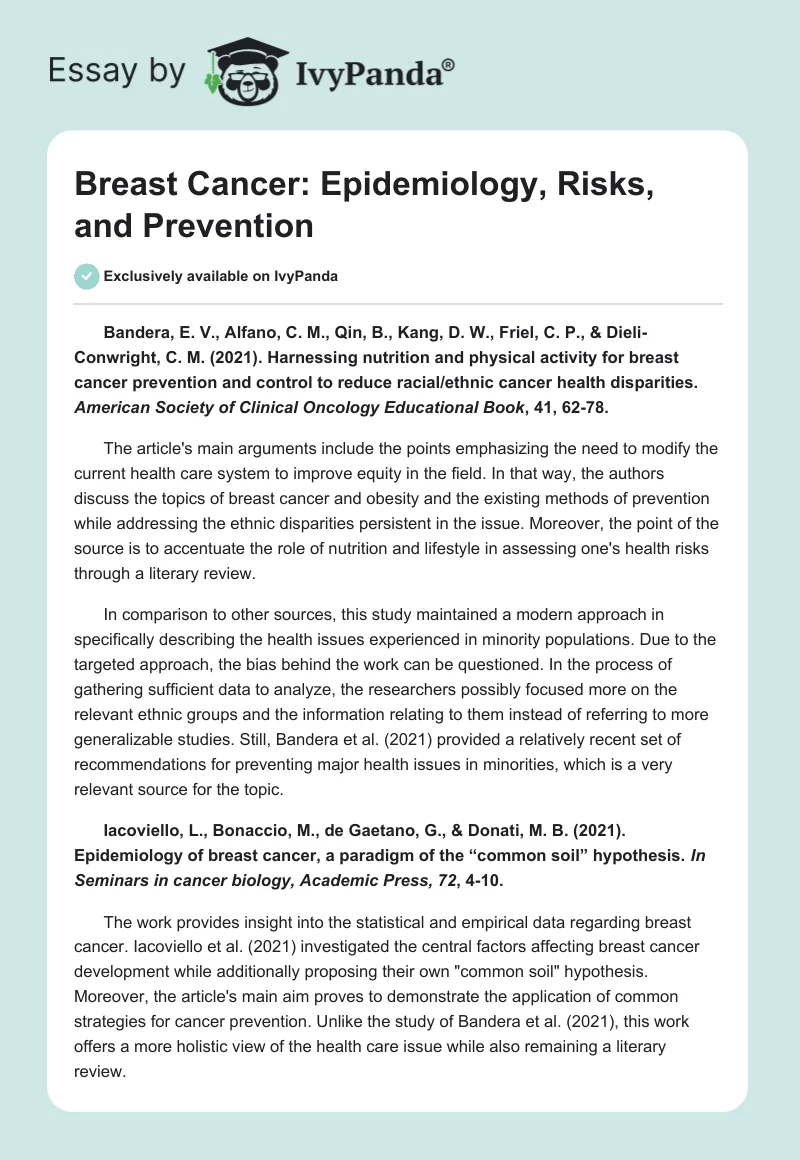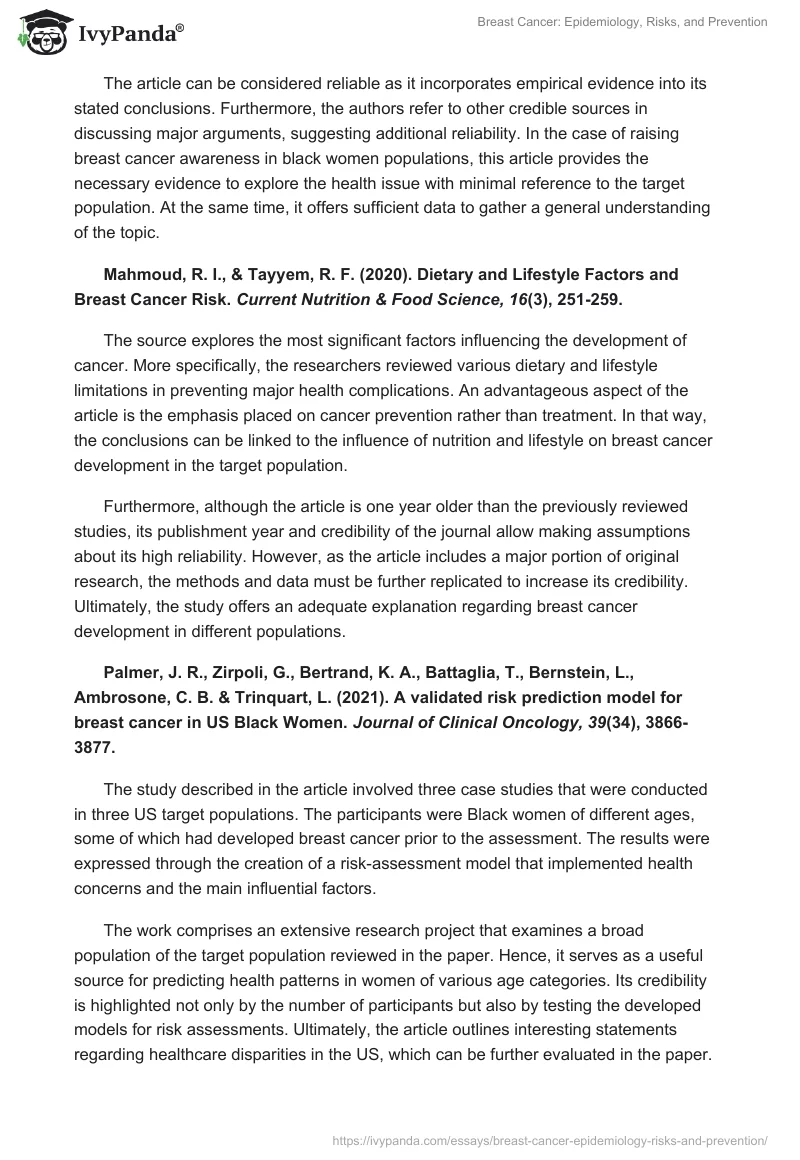Bandera, E. V., Alfano, C. M., Qin, B., Kang, D. W., Friel, C. P., & Dieli-Conwright, C. M. (2021). Harnessing nutrition and physical activity for breast cancer prevention and control to reduce racial/ethnic cancer health disparities. American Society of Clinical Oncology Educational Book, 41, 62-78.
The article’s main arguments include the points emphasizing the need to modify the current health care system to improve equity in the field. In that way, the authors discuss the topics of breast cancer and obesity and the existing methods of prevention while addressing the ethnic disparities persistent in the issue. Moreover, the point of the source is to accentuate the role of nutrition and lifestyle in assessing one’s health risks through a literary review.
In comparison to other sources, this study maintained a modern approach in specifically describing the health issues experienced in minority populations. Due to the targeted approach, the bias behind the work can be questioned. In the process of gathering sufficient data to analyze, the researchers possibly focused more on the relevant ethnic groups and the information relating to them instead of referring to more generalizable studies. Still, Bandera et al. (2021) provided a relatively recent set of recommendations for preventing major health issues in minorities, which is a very relevant source for the topic.
Iacoviello, L., Bonaccio, M., de Gaetano, G., & Donati, M. B. (2021). Epidemiology of breast cancer, a paradigm of the “common soil” hypothesis.In Seminars in cancer biology, Academic Press, 72, 4-10.
The work provides insight into the statistical and empirical data regarding breast cancer. Iacoviello et al. (2021) investigated the central factors affecting breast cancer development while additionally proposing their own “common soil” hypothesis. Moreover, the article’s main aim proves to demonstrate the application of common strategies for cancer prevention. Unlike the study of Bandera et al. (2021), this work offers a more holistic view of the health care issue while also remaining a literary review.
The article can be considered reliable as it incorporates empirical evidence into its stated conclusions. Furthermore, the authors refer to other credible sources in discussing major arguments, suggesting additional reliability. In the case of raising breast cancer awareness in black women populations, this article provides the necessary evidence to explore the health issue with minimal reference to the target population. At the same time, it offers sufficient data to gather a general understanding of the topic.
Mahmoud, R. I., & Tayyem, R. F. (2020). Dietary and Lifestyle Factors and Breast Cancer Risk.Current Nutrition & Food Science, 16(3), 251-259.
The source explores the most significant factors influencing the development of cancer. More specifically, the researchers reviewed various dietary and lifestyle limitations in preventing major health complications. An advantageous aspect of the article is the emphasis placed on cancer prevention rather than treatment. In that way, the conclusions can be linked to the influence of nutrition and lifestyle on breast cancer development in the target population.
Furthermore, although the article is one year older than the previously reviewed studies, its publishing year and credibility of the journal allow making assumptions about its high reliability. However, as the article includes a major portion of original research, the methods and data must be further replicated to increase its credibility. Ultimately, the study offers an adequate explanation regarding breast cancer development in different populations.
Palmer, J. R., Zirpoli, G., Bertrand, K. A., Battaglia, T., Bernstein, L., Ambrosone, C. B. & Trinquart, L. (2021). A validated risk prediction model for breast cancer in US Black Women.Journal of Clinical Oncology, 39(34), 3866-3877.
The study described in the article involved three case studies that were conducted in three US target populations. The participants were Black women of different ages, some of which had developed breast cancer prior to the assessment. The results were expressed through the creation of a risk-assessment model that implemented health concerns and the main influential factors.
The work comprises an extensive research project that examines a broad population of the target population reviewed in the paper. Hence, it serves as a useful source for predicting health patterns in women of various age categories. Its credibility is highlighted not only by the number of participants but also by testing the developed models for risk assessments. Ultimately, the article outlines interesting statements regarding healthcare disparities in the US, which can be further evaluated in the paper.
Parada Jr, H., Sun, X., Tse, C. K., Olshan, A. F., & Troester, M. A. (2019). Lifestyle patterns and survival following breast cancer in the Carolina Breast Cancer Study.Epidemiology, 30(1), 83.
The study utilized interviews of over 1,000 women to develop a link between breast cancer survival risks and lifestyle patterns. The research design used allowed the researchers to analyze the gathered data statistically and make the necessary conclusions. In that way, three major health groups were identified as the “unhealthy behavior and diet” conditions that exhibited the highest mortality risks following a breast cancer diagnosis.
The wide age spectrum of the participants and incorporation of several secondary factors increases the credibility of the article. Additionally, the involvement of over a thousand women in the interview raises the probability of the target population being investigated as well. In comparison to the other articles, Parada et al. (2019) conducted their own research design and specified the whole procedure. Lastly, the source offers developed lifestyle patterns on the basis of the interview and its follow-up results. This source was helpful as it also demonstrated the methodological approach to studying the target population.
Shoemaker, M. L., White, M. C., Wu, M., Weir, H. K., & Romieu, I. (2018). Differences in breast cancer incidence among young women aged 20–49 years by stage and tumor characteristics, age, race, and ethnicity, 2004–2013.Breast Cancer Research and Treatment, 169(3), 595 606.
The final article reviewed in the bibliography analysis focuses on breast cancer progression among women of different ages and ethnicities. The researchers utilized a database to track breast cancer cases and link their development to various external variables. In the end, the results indicated a higher tendency of breast cancer occurrence in Black women aged forty and over. Hence, the authors accentuated the importance of acknowledging cultural or ethnic factors while constructing fair healthcare systems.
The source proves valuable due to its increased generalizability to a big ethnic population and specific outline of the methods required to study breast cancer instances in Black women. The results are also strongly connected to the issue of lifestyle and other factors affecting the chances of breast cancer development. The article’s credibility is demonstrated through the analysis of existing credible sources. Ultimately, the work of Shoemaker et al. (2018) functions as a key empirical source for answering the research question.


